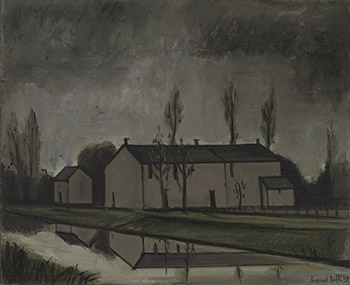PROVENANCE:
Galerie Maurice Garnier, Paris
Private collection, Asia
This painting is sold with a certificate of authenticity issued by Galerie Maurice Garnier, Paris
Catalogue Note:
“PAINTING: ONE DOESN’T TALK ABOUT IT, ONE DOESN’T ANALYZE IT, ONE FEELS IT.” – BERNARD BUFFET
MAISON AU BORD DU CANAL
BERNARD BUFFET
Bernard Buffet is perhaps one of the most controversial French Expressionist painters of the twentieth century; his figurative paintings are enticing in composition. His oeuvre includes still life, figures, animals and leisurely scenes with references made to concepts of art history, sexuality, popular culture, religion and politics. The prolific artist had explored with lithography, engraving, sculpture, designed stage sets for the Paris Opera’s ballet and worked on numerous book illustrations such as the Jean Cocteau’s La Voix Humaine. “Maison au bord du canal” epitomizes the artist’s distinctively stark, somber graphic style of heighten optical illusion, depicting several isolated and structurally simplistic windowless houses amidst elongated slender trees, its reflection quietly appearing on the motionless canal set alongside the houses horizontally. The crispness of Buffet’s lines always display technical skill that brings forth a sense o f melancholy that underlies the inherent complexity of Buffet’s aesthetic. “Maison au bord du canal” is another remarkable work from the fifties that remains especially melancholically poignant and true to Buffet’s signature style, all the while portrayed the artist’s ability to reinvent himself time and again through his work. The fifties saw Buffet reached vertiginous heights of fame, as he became part of the nouvelle vague of postwar France, essentially deemed as youthful talent that contribute to the promise of renewed French dominance in the artistic and cultural world. In Buffet’s works, even in the most commonplace of French scenery, one will find a highly authentic and unique personalized approach to seeing and experiencing the world. In this regards, Buffet has proven time and again, his ability to reinvent banal themes and transpires them into emotional and gripping masterpieces.
Buffet had what many would regard as an interesting life trajectory, a dedicated painter of figures in a world had faced with incubus obstacles during the rise of abstraction. A world when the norm was to perceive Picasso’s abstraction as the future of art in France, where Buffet's facile figuration was seen as a throwback to an art world. In essence, Buffet entered the artistic scene as an aspiring shining star that later became a social phenomenon and subsequently diminished to a symbol of bourgeois ignorance of over-commercialization in the past that embellishes Buffet’s unique cinematic life story. In retrospect, Buffet studied at the prestigious Académie des Beaux Arts at age fifteen and worked in the studio of painter Eugène Narbonne while he was a student. He exhibited his first self-portrait at the “Salon des Moins de Trente Ans“ of Galerie Beaux-Arts in 1946 and gained recognition in the post-war Paris art scene as the co-winner of the Prix de la Critique in 1948, just a couple of weeks prior to his twentieth birthday. The artist’s first solo exhibition followed the following year in December at the Art Impressions bookstore in Paris subsequently. Since 1949, Buffet had held annual exhibitions, which were subsequently organized around a central theme. In the 1950s, Buffet settled with his lover Pierre Bergé in Provence, the impresario who would later leave Buffet in 1958. By then Bernard Buffet had a castle in the South of France, an island and a Rolls Royce. He also had a major retrospective at the Galerie Charpentier, a distinguished honor for a young painter. Buffet was to become a member of the antiabstraction group L'homme Témoin, a group of proponents for representational art at a time when abstraction began to gain predominance. Buffet had an extremely prolific career and has painted over 8,000 works, it is apparent that recent widespread resurgence of interest in the artist’s work has led to new heights and world record for one of his paintings at auction of Bernard Buffet, one of the most controversial artists of his time.
